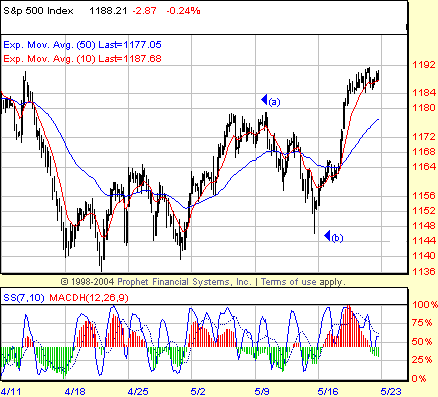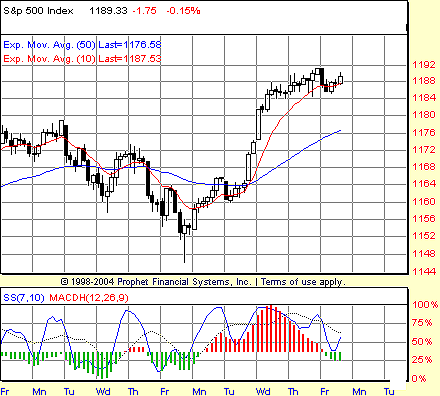
HOT TOPICS LIST
- MACD
- Fibonacci
- RSI
- Gann
- ADXR
- Stochastics
- Volume
- Triangles
- Futures
- Cycles
- Volatility
- ZIGZAG
- MESA
- Retracement
- Aroon
INDICATORS LIST
LIST OF TOPICS
PRINT THIS ARTICLE
by David Penn
Running stochastic divergences in the hourly chart of the Standard & Poor's 500 suggest that the vertical rally that began in late April might be running out of steam.
Position: N/A
David Penn
Technical Writer for Technical Analysis of STOCKS & COMMODITIES magazine, Working-Money.com, and Traders.com Advantage.
PRINT THIS ARTICLE
STOCHASTICS
Will Divergences Doom The Rally?
05/23/05 07:47:17 AMby David Penn
Running stochastic divergences in the hourly chart of the Standard & Poor's 500 suggest that the vertical rally that began in late April might be running out of steam.
Position: N/A
| For the record, my answer to the question asked at the outset is an uncategorical yes and no. |
| If you're aware of my recent Elliott wave piece for Traders.com Advantage ("Projectile Bottoming," May 12, 2005) talking about the March-April declines, then you'll recall that I believe that the bottom of the two-month decline was also the completion of a key five-wave movement. What is most important for our purposes is that after a five-wave movement is complete, a three-wave countertrend movement often follows it. That countertrend movement has characterized the Standard & Poor's 500 since mid- to late April (Figure 1). |

|
| Figure 1: Putting in a bottom in mid- to late April, the S&P 500's convoluted rally since then is a countertrend move that stands between the March-April declines and the likelihood of further declines to come. |
| Graphic provided by: Prophet Financial, Inc. |
| |
| For those keeping score at home, the low on April 20 was a wave 5 low, one that completed a five-wave decline from the peak in early March. I believe we are currently in the third, "c" stage of a wave 2 countertrend advance (a "bear market rally," if you will). The first stage of wave 2 was the "a" wave from the April 20th bottom near 1136 to the short-term top at 1179 on May 9. The second stage of wave 2 was the "b" wave, which took the S&P 500 back to 1146 on May 13. It is important to note that both the "a" and "b" waves were composed of three legs. This leads me to believe that wave 2 will take the form of a flat 3-3-5, with a final "c" wave that will have five parts instead of three. I suspect we've already seen the first four parts of wave "c"--which leaves only another advance to complete the pattern. This dovetails quite nicely with the appearance of a running negative stochastic divergence during the S&P 500's most recent (or "c" wave) advance. As Figure 2 shows, there are three consecutively lower stochastic peaks after May 16. And each of these consecutively lower stochastic peaks is accompanied by a consecutively higher price peak in the S&P 500. This is a classic negative divergence, and the fact that multiple divergences are occurring one after the other suggests even more bearish portents for the S&P 500. |

|
| Figure 2: Successively lower stochastic peaks early on Wednesday and late on Thursday correspond with successively higher price peaks in the $SPX. |
| Graphic provided by: Prophet Financial, Inc. |
| |
| In the context of the current advance--and my sense that the $SPX could reach 1215 before wave 2 is completed--it is worth recalling that negative stochastic divergences mean first that upside will be limited for a period of time. Whether that results in a tradable move to the downside or simply a pullback opportunity for old longs to add to their positions and new longs to take positions is difficult to determine in advance. Should the market indeed retreat from current levels, one likely source of support comes from the 50-bar exponential moving average (EMA) at the 1175 area. |
| PS: One note about the 1215 target. That target is derived from Elliott wave/Fibonacci theories, and comes from multiplying the length of wave "a" times the Fibonacci ratio of 1.618, and then adding that amount to the value at the bottom of wave "b." Wave "a" is approximately 43 points, 43 x 1.618 is about 69.58, and 69.58 + 1146 gives an upside of 1215.58. |
Technical Writer for Technical Analysis of STOCKS & COMMODITIES magazine, Working-Money.com, and Traders.com Advantage.
| Title: | Technical Writer |
| Company: | Technical Analysis, Inc. |
| Address: | 4757 California Avenue SW |
| Seattle, WA 98116 | |
| Phone # for sales: | 206 938 0570 |
| Fax: | 206 938 1307 |
| Website: | www.Traders.com |
| E-mail address: | DPenn@traders.com |
Traders' Resource Links | |
| Charting the Stock Market: The Wyckoff Method -- Books | |
| Working-Money.com -- Online Trading Services | |
| Traders.com Advantage -- Online Trading Services | |
| Technical Analysis of Stocks & Commodities -- Publications and Newsletters | |
| Working Money, at Working-Money.com -- Publications and Newsletters | |
| Traders.com Advantage -- Publications and Newsletters | |
| Professional Traders Starter Kit -- Software | |
Click here for more information about our publications!
Comments
Date: 05/23/05Rank: 3Comment:
Date: 05/24/05Rank: 5Comment:

|

Request Information From Our Sponsors
- StockCharts.com, Inc.
- Candle Patterns
- Candlestick Charting Explained
- Intermarket Technical Analysis
- John Murphy on Chart Analysis
- John Murphy's Chart Pattern Recognition
- John Murphy's Market Message
- MurphyExplainsMarketAnalysis-Intermarket Analysis
- MurphyExplainsMarketAnalysis-Visual Analysis
- StockCharts.com
- Technical Analysis of the Financial Markets
- The Visual Investor
- VectorVest, Inc.
- Executive Premier Workshop
- One-Day Options Course
- OptionsPro
- Retirement Income Workshop
- Sure-Fire Trading Systems (VectorVest, Inc.)
- Trading as a Business Workshop
- VectorVest 7 EOD
- VectorVest 7 RealTime/IntraDay
- VectorVest AutoTester
- VectorVest Educational Services
- VectorVest OnLine
- VectorVest Options Analyzer
- VectorVest ProGraphics v6.0
- VectorVest ProTrader 7
- VectorVest RealTime Derby Tool
- VectorVest Simulator
- VectorVest Variator
- VectorVest Watchdog
